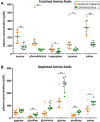Extensive alterations of blood metabolites in pediatric cerebral malaria
- PMID: 28426698
- PMCID: PMC5398544
- DOI: 10.1371/journal.pone.0175686
Extensive alterations of blood metabolites in pediatric cerebral malaria
Abstract
Cerebral malaria (CM) presents as an encephalopathy and is due to infection with Plasmodium falciparum. Patients are comatose, often with fever, recurrent seizures and this condition is associated with a high mortality rate. The etiology of the coma and seizures are poorly understood. Circulating small molecules and lipids have bioactive functions and alterations in their concentrations have been implicated in seizure disorders and other forms of encephalopathy. We carried out a comprehensive analysis of blood metabolites during CM to explore a biochemical basis of this encephalopathy. A paired metabolomics analysis was performed on the plasma samples of Malawian children (n = 11) during CM and at convalescence thirty days later, to identify differentially abundant molecules associated with CM. We also report plasma molecules associated with CM mortality (n = 4) compared to survival (n = 19). Plasma metabolites were identified through ultra high performance liquid chromatography/tandem mass spectrometry and gas chromatography/mass spectrometry to maximize compound detection and accuracy and then compared to a library for identification. We detected a total of 432 small molecules in the plasma and 247 metabolites were significantly differentially abundant between CM and convalescence (p < 0.05, FDR < 0.10). These represented global changes across many classes of molecules including lipids, amino acids and hemoglobin metabolites. We observed significant changes in molecules that could impact neurologic function during CM; these include increased levels of kynurenate and decreased indolepropionate, glutamate, arginine and glutamine. Moreover, 1-methylimidazoleacetate, kyurenate, arachidonic acid and dimethylarginine were associated with mortality (p < 0.05, fold change > 1.2). These results highlight the broad changes in blood chemistry during CM. We have identified metabolites that may impact central nervous system physiology and disease outcomes and can be further explored for their mechanistic roles into the pathophysiology of CM.
Conflict of interest statement
Figures



Similar articles
-
Depleted circulatory complement-lysis inhibitor (CLI) in childhood cerebral malaria returns to normal with convalescence.Malar J. 2020 Apr 26;19(1):167. doi: 10.1186/s12936-020-03241-5. Malar J. 2020. PMID: 32336276 Free PMC article.
-
Elevated plasma von Willebrand factor and propeptide levels in Malawian children with malaria.PLoS One. 2011;6(11):e25626. doi: 10.1371/journal.pone.0025626. Epub 2011 Nov 17. PLoS One. 2011. PMID: 22125593 Free PMC article.
-
Increased serum phospholipase A2 activity in Malawian children with falciparum malaria.Am J Trop Med Hyg. 1993 Oct;49(4):455-9. doi: 10.4269/ajtmh.1993.49.455. Am J Trop Med Hyg. 1993. PMID: 8214274
-
Proteomic profiling of the plasma of Gambian children with cerebral malaria.Malar J. 2018 Sep 24;17(1):337. doi: 10.1186/s12936-018-2487-y. Malar J. 2018. PMID: 30249265 Free PMC article.
-
Kinetic and Cross-Sectional Studies on the Genesis of Hypoargininemia in Severe Pediatric Plasmodium falciparum Malaria.Infect Immun. 2019 Mar 25;87(4):e00655-18. doi: 10.1128/IAI.00655-18. Print 2019 Apr. Infect Immun. 2019. PMID: 30718287 Free PMC article.
Cited by
-
Longitudinal associations of plasma amino acid levels with recovery from malarial coma.Malar J. 2024 Aug 23;23(1):253. doi: 10.1186/s12936-024-05077-9. Malar J. 2024. PMID: 39180112 Free PMC article.
-
Metabolic profiling during malaria reveals the role of the aryl hydrocarbon receptor in regulating kidney injury.Elife. 2020 Oct 6;9:e60165. doi: 10.7554/eLife.60165. Elife. 2020. PMID: 33021470 Free PMC article.
-
Longitudinal associations of plasma amino acid levels with recovery from malarial coma.Res Sq [Preprint]. 2024 May 24:rs.3.rs-4421190. doi: 10.21203/rs.3.rs-4421190/v1. Res Sq. 2024. Update in: Malar J. 2024 Aug 23;23(1):253. doi: 10.1186/s12936-024-05077-9. PMID: 38826416 Free PMC article. Updated. Preprint.
-
Host metabolomic responses in recurrent P. vivax malaria.Sci Rep. 2024 Mar 27;14(1):7249. doi: 10.1038/s41598-024-54231-5. Sci Rep. 2024. PMID: 38538661 Free PMC article.
-
Plasma Amino Acid Concentrations in Children With Severe Malaria Are Associated With Mortality and Worse Long-term Kidney and Cognitive Outcomes.J Infect Dis. 2022 Dec 13;226(12):2215-2225. doi: 10.1093/infdis/jiac392. J Infect Dis. 2022. PMID: 36179241 Free PMC article.
References
-
- WHO. World Malaria Report. Geneva, Switzerland: World Health Organization; 2015.
-
- Birbeck GL, Molyneux ME, Kaplan PW, Seydel KB, Chimalizeni YF, Kawaza K, et al. Blantyre Malaria Project Epilepsy Study (BMPES) of neurological outcomes in retinopathy-positive paediatric cerebral malaria survivors: a prospective cohort study. The Lancet Neurology. 2010;9(12):1173–81. Epub 2010/11/09. PubMed Central PMCID: PMC2988225. doi: 10.1016/S1474-4422(10)70270-2 - DOI - PMC - PubMed
-
- Idro R, Marsh K, John CC, Newton CR. Cerebral malaria: mechanisms of brain injury and strategies for improved neurocognitive outcome. Pediatr Res. 2010;68(4):267–74. PubMed Central PMCID: PMC3056312. doi: 10.1203/00006450-201011001-00524 - DOI - PMC - PubMed
-
- Grau GE, Craig AG. Cerebral malaria pathogenesis: revisiting parasite and host contributions. Future Microbiol. 2012;7(2):291–302. doi: 10.2217/fmb.11.155 - DOI - PubMed
-
- Taylor TE, Fu WJ, Carr RA, Whitten RO, Mueller JG, Fosiko NG, et al. Differentiating the pathologies of cerebral malaria by postmortem parasite counts. Nature medicine. 2004;10(2):143–5. doi: 10.1038/nm986 - DOI - PubMed
MeSH terms
Grants and funding
LinkOut - more resources
Full Text Sources
Other Literature Sources

